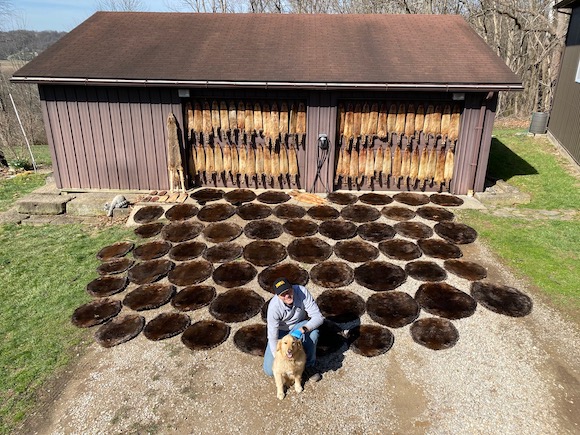 Team Fur News
Team Fur News
An Education in Waterfowling
By FUR-FISH-GAME Editor, John D. Taylor
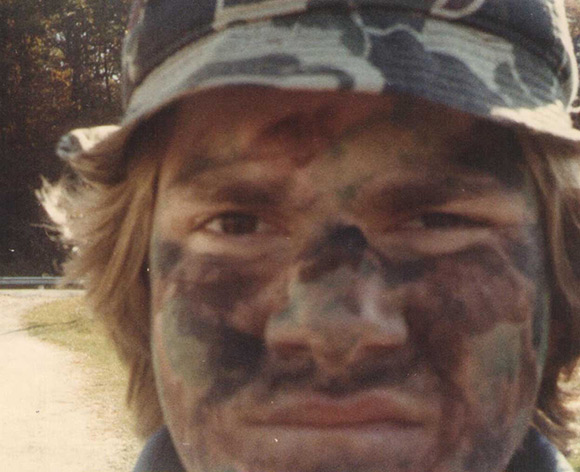
Young editor Taylor was a strong believer in face camouflage as a beginning waterfowler.
York College of Pennsylvania is where I received my degree in history and my higher education. To be honest, I didn’t apply myself as fully as I might have today. The courses I liked, I genuinely worked at. Those that didn’t strike my fancy, I only did enough to pass.
For example, I could really relate to Dr. James Morrison’s “Jacksonian America” and 19th century history classes. Doc Morrison was a Southerner, a Virginian, a horseman and he made learning about that period exciting. I’d been focused on the West since childhood, but he made me see how the era of Andrew Jackson, and its ramifications, helped forge the West that so fascinated me. Virginians, horsemen in particular, were my kind of people.
Somewhat his opposite was Dr. Phil Avillo. Avillo, a deep intellectual, was from New York City. He’d served with the Marines in Vietnam, where he lost a leg in combat. In his ancient history classes, we read Plutarch, Aristotle and Plato to explore that period. In his modern history classes, we read Freud, Marx, Sarte and Wittegenstein. Avillo’s objective was to get his students to understand the thinking of the people of the time, the zeitgeist – the spirit of the time – and view history through that lens. Avillo was also quick to challenge his students’ thinking, the Socrative method of learning. I went loggerheads with Avillo in essays and in class, and I think he tried to goad me, but It worked. I learned a lot. Something I didn't realize until later in life.
Both professors helped a naïve, younger version of myself see far more deeply into things than I had ever considered before, and I am grateful for their influence.
Then there were the classes where I didn’t apply myself.
I found making Dr. Wexler’s twice weekly 8:30 a.m. college algebra class a whole lot harder than getting up at 4:30 a.m. to throw a string of duck decoys into Lake Redman. I knew the direction I wanted to go in life back then – the outdoors was always my passion, and I wanted to earn a living in it, somehow. Besides, I hated math, probably the result of a high school algebra teacher’s lack of enthusiasm for what he was teaching. He’d drone on and on about integers and other algebra junk in post-lunch late afternoon classes that put anyone not crazy about math to sleep. I flunked his class, had to take a remedial algebra class the next high school semester. Yet I could talk fly fishing to this teacher until the cows came home. That, he was enthusiastic about. Mr. Berger, the remedial algebra teacher, helped me find the way through enough algebra to pass the course and eventually move on.
Anyhow, I was learning about duck hunting every bit as much as I was learning about Jacksonian America. No one in my family hunted waterfowl, yet I had a thing for it. I read all I could in magazines, including FUR-FISH-GAME, about duck hunting, and tried to emulate what I read.
One morning well before daylight, playing hooky from college algebra, I threw the 10 decoys I could afford into Lake Redman, in no particular pattern, hoping for the best. Previous experiences there said the ducks were always way far out. To remedy that problem I’d bought a Marlin Goose Gun, one of those 32-inch barrel, 12 gauge, bolt-action numbers, leaving my Winchester Model 1300 20 gauge pumpgun at home. The thinking – quite erroneous – was that the Goose Gun would reach the highflyers.
Dawn came, the ducks flew, and one low-flying duck came sailing towards my decoys within a reasonable range. I heaved the goose gun up, let loose, and wonder of wonders, the bird splashed into the lake.
Wading out to fetch my prize, I was surprised how dark this particular duck looked. It was no mallard, the main ducks on the lake. I wondered what I’d shot. A little water sloshed above my hip boots as I reached the bird. An ivory bill and long, green, individually webbed toes marked the slate gray bird’s unusual features.
A sudden wave of panic ripped through me.
I thought I’d killed some endangered wading bird or something. Any moment the long green arm of the Pennsylvania Game Commission would clap down on my shoulder. Or the feds would come swooping down to arrest me... There goes my lifetime of hunting, all for a little, ignorant mistake.
Was this penance for hooking out of college algebra?
I pulled the decoys, hightailed it out of there, taking the “duck” with me. At home, I whipped out my bird book and discovered that I’d shot a perfectly legal coot. I ate that coot and vowed to learn more about duck identification and duck hunting.
A short time later – and another college algebra class foregone – I was back on Lake Redman, on a little point that extended into the shallow water in the lake’s back bay. I was about the throw the decoys out again, when a voice came from behind me.
“Good morning,” the voice said.
Again, panic sliced through me. Who was this and what did they want? Game Commission? Feds? Did I have my duck stamp and license? I’d left the Goose Gun at home and was back to my pumpgun.
The voice turned out to be a guy named Jim. He wanted to hunt ducks, too, and do it from the same point I was on. That presented a problem, either we could cooperate and hunt together, or dispute “ownership” of the public land point.
Jim looked to be 15, maybe 20, years older than me. He had a big sack of decoys with him. And he looked like a real duck hunter, full camo, calls on a lanyard around his neck, not a duck “dude” like me.
So, we decided to hunt together. Jim suggested putting out our decoys in a V-shape, with a wide “hole” in the middle of the spread, a place where ducks could land if they came in. He talked about using the wind to add motion to the spread and facilitate ducks landing. When the decoys were set, we created a makeshift blind of driftwood, goldenrod stems and cattails to hide behind. Jim explained about the different types of duck calls – the hail call as the birds approached way out, the feeding chuckle as they flew overhead, then the plaintive callback if they decided veer away.
At dawn, ducks flew overhead, Jim called, and the birds pitched into our spread. We shot, but the ducks flared as we rose to shoot, so we missed. I’d never had that happen before. Wow... So, that’s what it was all about.
It was almost always once and done at Lake Redman – one opportunity and if you blew it, the ducks were gone, off to feed in small, private land ponds surrounding the lake. I learned a whole lot from Jim that morning, just talking to him about duck hunting.
I never saw or hunted with Jim again, although I looked for him many mornings. I think he was a businessman, and business took priority over duck hunting. Perhaps a lesson I should have learned about college algebra.
From that day on, my decoy spreads drew ducks, and my opportunities grew. One blustery morning a hen mallard tried pitching into my decoys. She seemed stationary flying against the blow. I aimed the pumpgun like a rifle, shot, and she fell, my first duck.
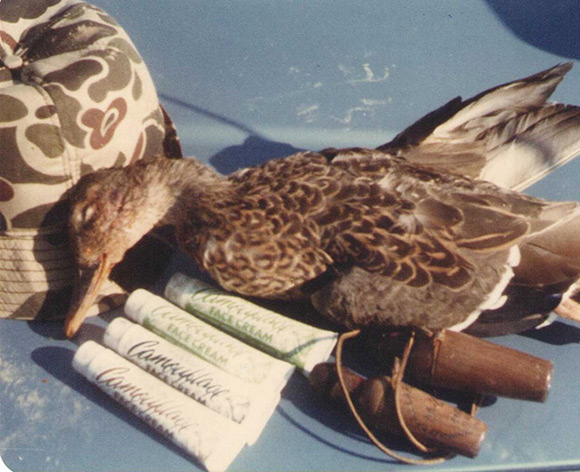
Taylor’s first duck a hen mallard.
My waterfowling grew in the seasons that followed. One day, well upstream on the East Branch of Codorus Creek, Lake Redman’s water source, the neighbor kid and I set pods of decoys in two groups and watched a dozen wood ducks come into them. We took several woodies from the group, the drakes the prettiest ducks I’d ever seen. I still tie flies using their feathers.
Later, I began hunting the Susquehanna River whenever possible with Bob, a high school friend, who had a canoe. We’d park the canoe on an island, set decoys in the shallows and hunt from impromptu blinds. We killed some ducks on that big river, scary when the chop exceeded the overloaded canoe’s gunwales.
One morning, Bob shot a duck that sailed, wounded, out toward mid-river. He had an electric trolling motor on the canoe and used it to try to reach the duck. He’d stop the motor, raise his shotgun and try to finish the duck, but the big chop bounced him around, while the bird’s diving made hitting it difficult. I watched, helpless, with no way to get back to shore, no way to help him if he capsized, knowing the Susquehanna had devoured many waterfowlers, including a friend from the grocery store I worked at, in its rush to reach the Chesapeake Bay.
Later, in the 1980s, wildlife artist Denny Burkhart and I shared several river mornings from his big, permanent blind in mid-river, near Washington Boro. His spread of hand-carved and painted canvasbacks, black ducks, mallards and pintails was a thing to behold in the morning sunlight. And he taught me the essentials of big water duck calling. His calling could pull birds from other decoy spreads and bring them into his. Amazing.
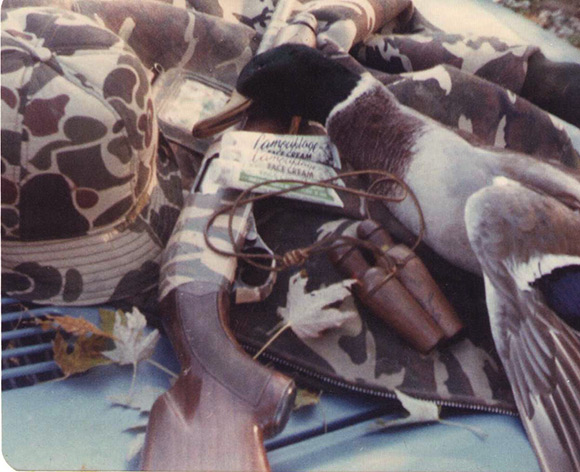
Taylor’s first drake mallard.
In the 1990s, I hunted ducks in northern Maine from my own Mad River “Duck Hunter” paddle-powered canoe, portaging over rocky segments of creeks connecting ponds or small lakes. I took that same canoe on a long trip in the early 2000s to the Dakotas, Montana and Oregon. I shot some teal and spoonbills in a muddy National Wildlife Refuge pothole in Montana, and mallards in a tidal marsh on Oregon’s coast. In that marsh, it felt weird to have plenty of water to float the decoys one moment, then a few minutes later, as the tide went out, the decoys sat on the marsh bottom.
Later, in North Dakota, ducks and geese, both Canadas and snows, occupied a good amount of my hunting interest when we lived there. Pothole hunting has its charms – generally small waters, a variety of puddle ducks (mallards, gadwalls, pintails, widgeon) and fairly easy shooting.
Through it all though, I’ve always wondered about Jim. What became of him after that day we hunted? I owe him a debt that hooking out of college algebra class cannot repay. If he’s reading this, thank you Jim.
Oklahoma Quail Numbers Up
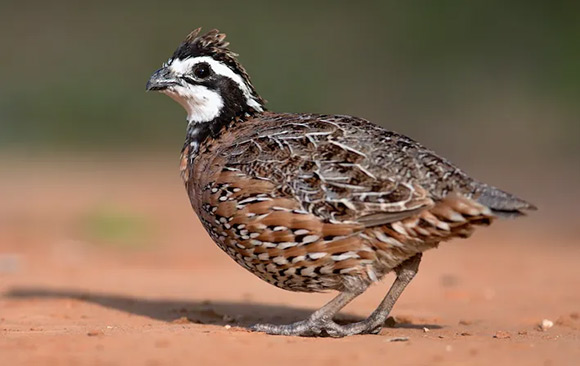
Oklahoma saw a 92% increase in bobwhite quail numbers in August survey routes thanks to cooler, wetter El Nino weather during the spring breeding season. Photo: ODWC)
The Oklahoma Department of Wildlife Conservation’s (ODWC) Upland Game Biologist, Tell Judkins, has some good news for hunters. August’s roadside quail survey shot up from last year’s 2.23 birds per route to 6.52 quail per route. This increase is 92.3% greater than the 10-year average of 3.39 per route. Pheasant survey results were up from last year, as well. ODWC employees survey 81 routes in 75 of Oklahoma’s 77 counties. While August surveys aren’t the most reliable predictor for hunting seasons, Judkins said the significant jump for quail is reason for higher expectations for more birds on the landscape this year. Another round of quail surveys was to be conducted prior to the early November quail opener. Pheasant season opens December 1. El Nino helped drive quail numbers to an eight-year high Judkins noted. Oklahoma’s 2023 - 2024 winter was mild, with only a few major cold snaps. After three consecutive years of La Nina (warmer/dryer) weather patterns, last spring’s El Nino (cooler/wetter) weather led to improved habitat conditions and the potential for better quail numbers. Fortunately, that El Nino persisted until April, benefitting the birds with habitat and insects for chicks. All regions of the state except the southeast improved from the 2023 survey. All regions, other than the southeast, are currently above their historic 35-year and 10-year averages. The age structure of observed quail shows 54.2% full grown, 38.3% three-fourths grown, 6.8% half grown, and 0.8% one-fourth grown birds. – and indicator of successful early broods with additional nesting throughout the summer. However, drought is now affecting about 75% of Oklahoma, especially in the southwest Oklahoma’s quail season opened Nov. 9 and runs through February 15, 2025. Many public areas in western Oklahoma will be closed February 1-15, 2025, for nonresident quail hunters. Bag limits remain 10 quail daily. For more information, consult the Oklahoma Fishing and Hunting Regulations online at wildlifedepartment.com/hunting/regs.
Colorado Mountain Lion Incident Investigated
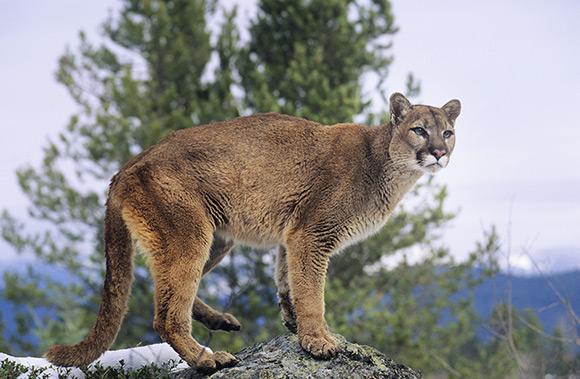
Colorado Parks and Wildlife is investigating the case of a cougar that was killed with a shovel by a man protecting himself and his husky dog. Photo: sirtravelalot/Shutterstock
On Sept. 26, a Colorado Parks and Wildlife (CPW) officer in Cañon City responded to a report of an aggressive mountain lion that had been killed by a man. The CPW officer found the man with a dead lion on the hood of his Jeep in a campground west of Cañon City, in Fremont County. The man told CPW that he was sitting outside his recreational vehicle with his dog the previous night when a female mountain lion weighing about 95 pounds (CPW estimate) approached them. The man said his dog, a husky, began growling and barking as the lion approached. When the lion got within about 10 feet, the dog engaged it and the man grabbed a shovel, struck the lion in the head, killing it. The CPW’s preliminary finding was that the man was in fear of his life and acted in self-defense when confronted by an unusual and extremely aggressive lion. Further inspection of the lion revealed an injury to its front right paw and scratches along its back. The lion’s body was shipped to a CPW animal health lab for a necropsy. Because the man suffered no injuries and was never touched by the lion, this incident does not qualify as a mountain lion “attack” under CPW guidelines. Such attacks are rare in Colorado. CPW recorded 25 lion attacks on humans since 1990. CPW urges the public to reduce the risk of problems with mountain lions by following some simple precautions:
• Make lots of noise from dusk to dawn, when mountain lions are most active. Outside lighting can help. Also, removing vegetation to eliminate hiding places for lions can make it difficult for lions to approach unseen.
• Planting non-native shrubs and plants that deer often prefer encourages wildlife to come onto your property. Predators follow prey. Never feed wildlife.
• Closely supervise children whenever they play outdoors. Get kids inside before dusk and don’t let them go out before dawn. Talk with children about lions and teach them what to do if they meet one.
• Keep pets under control. Roaming pets are easy prey and can attract lions.
• Place livestock in enclosed sheds or barns at night. Close doors to all outbuildings since inquisitive lions may go inside for a look.
Visit cpw.state.co.us/living-mountain-lions for more information on living with mountain lions.
Grasslands Conservation Act Introduced in U.S. House
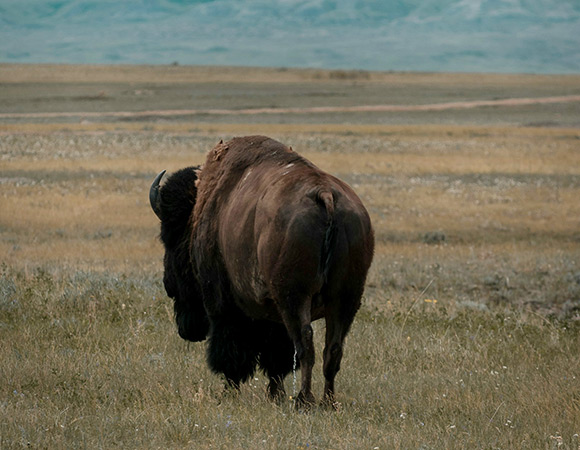
The North American Grasslands Conservation Act, modeled after the successful
North American Wetlands Conservation Act, would kickstart the voluntary protection
and restoration of grasslands and sagebrush-steppe ecosystems – and the livelihoods
and wildlife dependent upon them – if approved. Photo: Sekwang Chia/Unsplash
A bill that supports the protection of America's grasslands and shrub ecosystems, the North American Grasslands Conservation Act, was introduced in the U. S. House of Representatives by Representatives Nancy Mace (R – S.C.), Sharice Davis (D – Kan), Brian Fitzpatrick (R – Penn) and Mike Thompson (D – Calif). Once passed, the legislation will be one of the most significant steps for grassland conservation efforts in the 21st century.
More than 70 percent of America’s tallgrass, mixed grass, and shortgrass prairies have vanished, followed by the precipitous decline of grassland bird populations – more than 30 percent since 1966. Additionally, grazing lands that have sustained generations of ranchers are dwindling and species from bobwhite quail and pheasants to monarch butterflies and elk are struggling to navigate landscapes they used to call home.
The Grasslands Act would kickstart the voluntary protection and restoration of grasslands and sagebrush-steppe ecosystems – and the livelihoods and wildlife dependent upon them. The legislation is modeled after the successful North American Wetlands Conservation Act (NAWCA) and would create a landowner-driven, voluntary, incentive-based program to conserve America’s critically imperiled grasslands. There’s urgency to maintain these grassland biomes for agriculture, wildlife habitat, carbon sequestration and for future generations while supporting ranchers, farmers, Tribal Nations, sportsmen and women and rural communities. More than 45 organizations are collaborating in support of the Grasslands Act. A full roster of those groups can be found at www.ActforGrasslands.org. Additionally, the Cornell Lab of Ornithology has partnered with the coalition to develop the www.MapForGrasslands.org website, which provides a powerful tool to visualize the loss of grasslands habitat.
New Law Prohibits Sale of Bear Paws, Organs
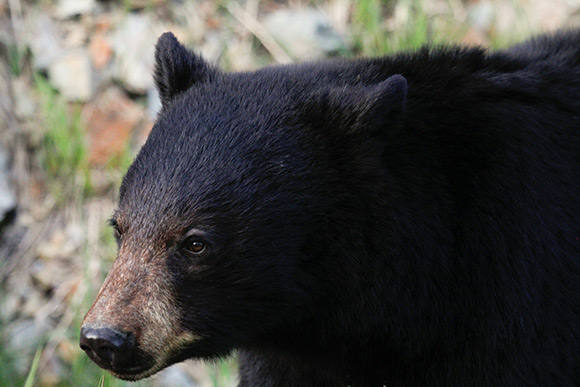
A new Vermont Law now prohibits the sale of bear paws or organs. Photo: Geoff Brooks/Unsplash
The Vermont Fish and Wildlife Department reminds hunters that the sale of bear paws and internal organs is prohibited by a new law. Vermont game wardens have investigated cases where people from out of state have approached Vermont hunters to purchase bear paws and gallbladders, which are valuable in Asian countries, according to Fish and Wildlife Commissioner Christopher Herrick. Vermont was one of the few states that still allowed the sale of bear paws and gall bladders that were later re-sold on the black market. No longer. Bear, deer or moose meat can be sold within Vermont during the open hunting season and for 20 days after the season ends, but the meat may not be bought or sold to be transported out of state. A person may also buy or sell the head, hide, hoofs and antlers of legally taken deer or moose and the head and hide of legally taken black bears at any time.
Ohio Musky Stocking Provides Outstanding Fishing
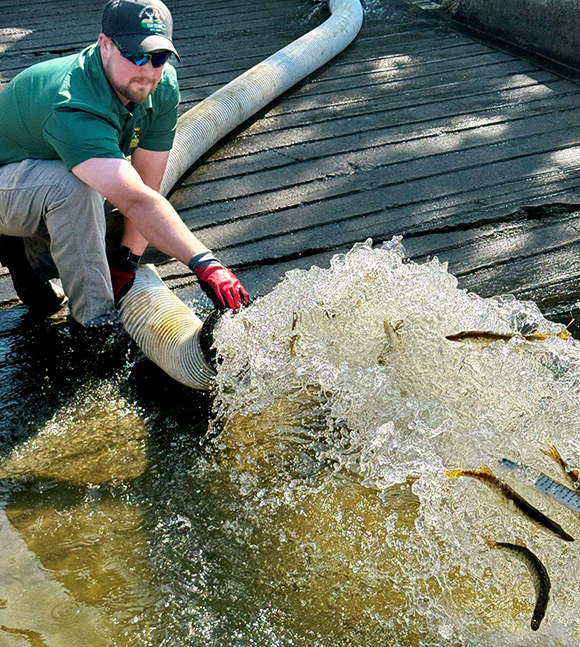
The Ohio Department of Natural Resources stocked nearly 20,000 muskies in nine lakes during 2024 and expects to offer anglers good fishing in the years to come.
The Ohio Department of Natural Resources (ODNR) Division of Wildlife stocked nearly 20,000 muskellunge in nine inland lakes across the state in 2024. Muskies can grow to more than 50 inches in length and are a popular sport fish for anglers. ODNR raises muskies at the Kincaid and London state fish hatcheries. The hatcheries then stock 10- to 12-inch muskies in nine lakes each fall. Muskies are a predatory sport fish that grow quickly and create trophy fishing opportunities in Alum Creek Lake, C. J. Brown Reservoir, Caesar Creek Lake, Clearfork Reservoir, Lake Milton, Leesville Lake, Piedmont Lake, Salt Fork Lake, and West Branch Reservoir. Trophy muskies have been documented across the nine stocking locations. In addition, muskies are caught in many of Ohio’s river systems. ODNR created the Muskie Angler Log (https://apps.ohiodnr.gov/MuskieLog/welcome.aspx) to gather public reports of muskie catches and use that information to better manage the fishery. Muskies longer than 40 inches have been recorded in each of the nine stocked lakes, and seven of those lakes have hosted muskie longer than 50 inches. Ohio’s state record muskie, weighing 55.1 pounds and measuring 50.25 inches long, was caught in Piedmont Lake in 1972. Anglers who catch a muskie 40 inches or longer are eligible to receive a Fish Ohio award. The top 10 muskie waters include: West Branch Reservoir (102 Fish Ohio entries), Leesville Lake (48), Piedmont Lake (42), Alum Creek Lake (24), Salt Fork Lake (18), Caesar Creek Lake (17), Mahoning River (17), Clearfork Reservoir (11), Lake Milton (11), Pymatuning Lake (8)
Arizona, California See Good Quail, Chukar Hunting Ahead
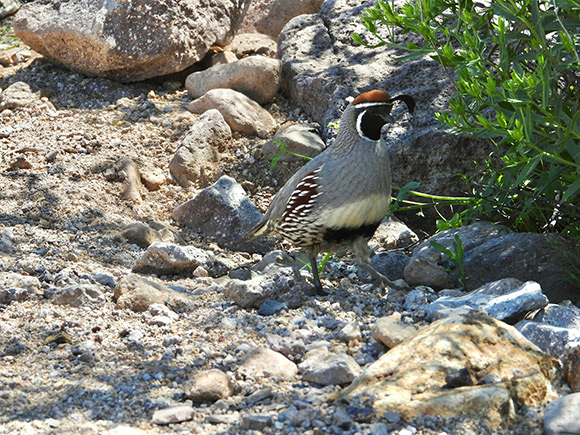
Gambel’s quail, found in both Arizona and California, are expected to be abundant this fall according to the state wildlife agencies. Photo: Steve Barb Sande/Unsplash
The Arizona Game and Fish Department (AZGFD) is expecting a "solid" season for quail hunting opportunities this year. Quail season is already under way for some species, while Mearns’ quail season opens December 6. “This should be a solid year for Gambel’s quail numbers,” said Dr. Larisa Harding, small game program manager. “That’s where I would encourage hunters to focus their efforts on this year. Harding also expected hunting success for Mearns’ quail to be spotty, with some locations with good numbers of birds, others not so many. Summer rainfall played a key role in nesting success and increasing populations. After a statistically above-average monsoon season across parts of southern Arizona, Mearns’ quail are likely to be found in pockets that received sufficient rainfall.
A valid Arizona hunting, or combination hunt and fish license, is required for all hunters 10 and older. The general bag limit is 15 quail per day, with no more than eight Mearns’ quail. The possession limit is 45 quail in aggregate with no more than 15 Gambel’s, scaled or California quail taken in any one day. Quail seasons close February 9, 2025. Also, endangered masked bobwhite quail recovery efforts continue in southern Arizona. Captive breeding and reintroductions have been successful in and around the Buenos Aires National Wildlife Refuge. As a result, game management units 36A, 36B and 36C hold the endangered masked bobwhites. Since the masked bobwhite is federally protected under the Endangered Species Act, shooting one could result $8,000 state fines, additional federal fines, fees and jail time. Hunters must know their target since Mearns’ quail and masked bobwhites share similarities in appearance and behavior.
The California Department of Fish and Wildlife (CDFW) also anticipates good quail and chukar hunting. California has three native species of quail – the California quail, the mountain quail and the Gambel’s quail. Every county is home to at least one of these species. The state is divided into three quail hunt zones, with a statewide season running through January 26, 2025. Hunters may take up to 10 quail per day in any species combination. Chukars, native to Eurasia, were introduced in the 1930s and have found suitable habitat in the remote, arid, rocky, steep slopes along the eastern edge of California, stretching from the high desert plains of Modoc and Lassen counties south into the Mojave Desert and Death Valley.
CDFW notes that quail and chukar populations boom and bust with rainfall among other factors. Rain supports the insect populations critical for young birds and the growth lupine, clover, chickweed, filaree and fiddleneck plants – quail and chukar food. With above average rainfall last winter, quail and chukar numbers increased Hunters who are fit, accompanied by good dogs or otherwise lucky enough may take six chukar per day. A valid California hunting license and an upland game bird validation is required for hunting quail and chukar and all migratory and resident upland game birds. Money generated from validation/stamp sales is dedicated to upland game bird-related conservation projects, education, hunting opportunities and outreach. Visit wildlife.ca.gov.
South Dakota Artist Wins 2024 Duck Stamp Contest
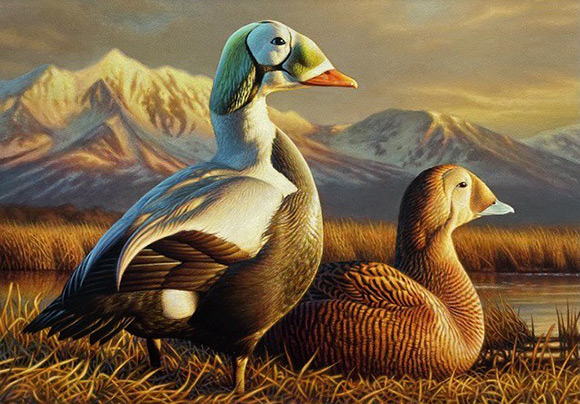
South Dakota artist Adam Grimm’s acrylic painting of a pair of spectacled eiders will be the art used for the 2025-26 Federal Duck Stamp. Photo: USFWS
Adam Grimm, of Wallace, South Dakota, won the 2024 Federal Duck Stamp Art Contest with an acrylic painting of a pair of spectacled eiders. Grimm’s artwork, chosen from among 239 entries, will be made into the 2025-2026 Federal Migratory Bird Hunting and Conservation Stamp, or Duck Stamp, which will go on sale in late June 2025. This is Grimm’s third time winning the Federal Duck Stamp Art Contest. The U.S. Fish and Wildlife Service produces the Federal Duck Stamp, which raises nearly $40 million annually, funds that support critical conservation to conserve wetland habitats in the National Wildlife Refuge system for the benefit of wildlife and the enjoyment of people. Since it was first established in 1934, the Federal Duck Stamp has raised more than $1.3 billion to conserve more than 6 million acres of habitat for birds and other wildlife. Waterfowl hunters age 16 and older are required to purchase and carry the current Federal Duck Stamp. Many non-hunters, including birdwatchers, conservationists, stamp collectors and others also purchase the stamp in support of habitat conservation. And a current Federal Duck Stamp can be used for free admission to any national wildlife refuge. Grimm’s work “Winter Hunter” will also grace the cover of FUR-FISH-GAME’s January issue (see below our January cover).
Rare Canada Lynx Sighted in Vermont
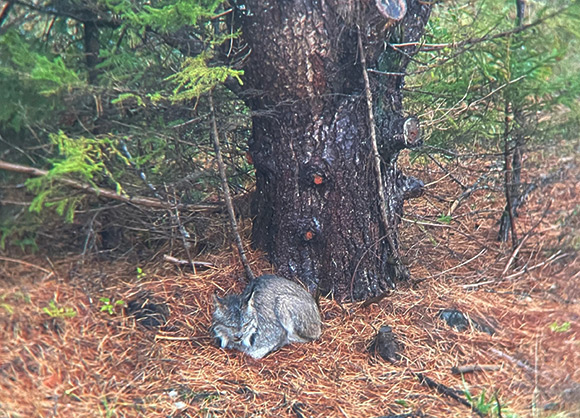
This Canada lynx was photographed in late September 2024, in Addison County. Photo: VFWD
The Vermont Fish and Wildlife Department (VDFW) confirmed that a rare Canada lynx was spotted in Vermont in August. This is the first time in years the cat was seen in the state. And biologists with have continued to receive verifiable photos and videos of what they believe is the same individual wild cat. Reports indicate that the lynx moved about 60 miles north of where it was first sighted in Rutland County into Addison County, traveling around a dozen miles at a time and then staying in the same general area for several days before moving on. Juvenile lynx will often travel long distances searching for new territory, a behavior called “dispersal” by biologists. “We’ve had 15 confirmed lynx sightings since August and signs point to these all being the same dispersing juvenile male,” said Brehan Furfey, furbearer biologist with the department. “That’s a conservation success in its own right because Vermont’s network of protected lands is what makes this journey possible. We’re rooting for this lynx to keep heading north where it will find more young forest habitat and plenty of snowshoe hares to eat.” Canada lynx are a federally threatened species, so VDFW says it is important for anyone who sees a lynx to give the cat a respectful amount of space.
Historic Wisconsin Elk Hunt
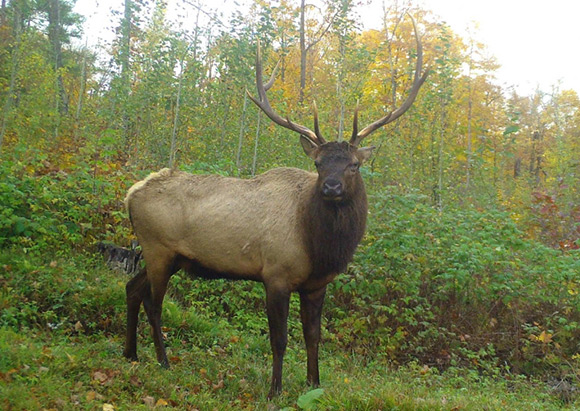
Wisconsin’s recent elk hunt, the seventh season since elk were reintroduced to the state, is also the first time hunters had an opportunity to hunt in both the Northern and Central Elk zones. Photo: WDNR
The Wisconsin Department of Natural Resources (WDNR) celebrated the 2024 elk hunting season in mid-October. The hunt was Wisconsin's seventh elk season since the reintroduction of elk, but it also represented a milestone with the first season hunters had an opportunity to hunt in both the Northern and Central Elk Zones. Previous hunts only occurred within the Northern Elk Zone. "Wisconsin's central elk herd has reached an exciting milestone," said Christiana Kizewski, WDNR Central Elk Zone biologist. "The herd's population is now at a level that allows for a limited hunt. This underscores the successful management of Wisconsin's healthy and growing elk herd." WDNR approved an eight-bull harvest quota for the Northern Elk Zone and a four-bull quota for the inaugural season in the Central Elk Zone. Per treaty rights, the Ojibwe tribes have declared four bulls of the eight-bull harvest quota for the Northern Elk Zone. The eight hunters participating in the state-administered hunt were randomly selected from a pool of more than 25,000 applicants. WDNR received 17,761 applications to hunt in the Northern Elk Zone and 7,750 applications for the Central Elk Zone. The random drawing ensures that each applicant has an equal chance of selection within the zones. Hunters can apply for 2025 elk hunting beginning in March of 2025. WDNR's elk management is driven by the hunter application fees. For each $10 application fee, $7 goes directly toward elk management, habitat restoration and research. The 2025 elk hunt application period is expected to open with the new license year on March 1 and run through May 31, 2025. The 2025 elk hunting season will open on Saturday, Oct. 18. Hunters must select which unit they would like to hunt during the application process. Visit https://dnr.wisconsin.gov/topic/wildlifehabitat/elk
Maine Creates Two Do Not Eat Wildlife Consumption Advisory Areas
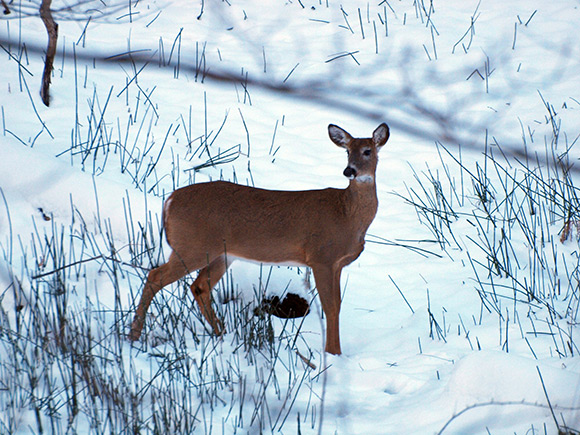
The Maine Department of Inland Fisheries and Wildlife along with the state’s Center for Disease Control and Prevention has issued a “Do Not Eat” wildlife consumption advisory for areas in portions of Unity, Unity Township, Albion and Freedom, due to contamination by PFAS. Photo: Ben Beuchel/Unsplash
The Maine Department of Inland Fisheries and Wildlife (MDIFW) with the state’s Center for Disease Control and Prevention (MCDC), has issued a “Do Not Eat” wildlife consumption advisory for two different areas in portions of Unity, Unity Township, Albion and Freedom. MDIFW and MCDC recommend no one eat deer or wild turkeys harvested in these wildlife consumption advisory areas. One advisory area is 5.5 square miles, the other 4.3 square miles. These advisory areas are in addition to the current advisory area in Fairfield and parts of Skowhegan. The new advisory areas are the result of extensive wildlife sampling in eastern Kennebec and western Waldo counties to examine the impact of PFAS on wildlife. MDIFW and MCDC tested 54 deer and 55 wild turkeys in these counties for the presence of PFAS. Research showed that wildlife within a mile of the areas with high PFAS soil concentration levels resulted in animals that had levels of PFAS in their muscle tissue. This warranted the advisory, MDIFW says. The advisory locations have been contaminated by high levels of PFAS through the spreading of municipal and/or industrial sludge containing PFAS. Deer and turkeys fed in these contaminated areas, ingested these chemicals and now have PFAS in their meat and organs.
PFAS (per- and Polyfluoroalkyl substances), also known as “forever chemicals,” have been used for decades in a variety of household and consumer products, including non-stick cookware, carpet, waterproof clothing and food packaging products such as pizza boxes and microwave popcorn bags. PFAS persist in the environment – why they’re called forever chemicals – in soil, water, plants and animals. Over time, exposure to these chemicals has been known to increase the risk of some types of cancer, decrease infant and fetal growth, increase cholesterol levels and impair the immune system. New Hampshire, Michigan and Wisconsin have also issued consumption advisories concerning PFAS and deer. The New Hampshire and Wisconsin advisories are for non-consumption of the liver and do not include meat. MDIFW plans to continue working with other state agencies on this issue and to continue to test deer and other wildlife to determine the extent of PFAS in Maine’s wildlife. For more information on the advisory areas, visit https://www.maine.gov/ifw/hunting-trapping/hunting/laws-rules/pfas-related-consumption-advisory.html. For more information on the environmental impact of PFAS, visit https://www.maine.gov/dep/spills/topics/pfas/index.html, or call (207) 287-8000.
UPCOMING EVENTS
Indiana State Trappers’ Association Fur Sales - Two 2025 Indiana State Trappers’ Association (ISTA) Fur Sales will take place in 2025: The first takes place on January 25, 2025, at the Old Friendship Church, in Linville, Indiana. The second will take place on February 8, in Peru, Indiana, at the Miami County Fairgrounds. You must be an ISTA member to sell. Lot numbers can be purchased prior to the sale date. Doors open at 8 a.m. Sales begin promptly at 9 a.m. local time. Note: Linville is in the Central Time Zone and Peru is in the Eastern Time Zone. Fur buyers from several states will be in attendance. The events include food, trap raffles, 50/50 contests and other activities. Come for the fun and enjoy the largest fur sales in Indiana. For more information call or text Byron Tiede at (219) 863-3803.
New Mexico Trappers’ Association Fur Sales and Rendezvous -The New Mexico Trappers’ Association (NMTA) will hold three events in 2025: A Trappers’ Fur Sale will take place on February 28 and March 1, 2025, at the Torrance County Fairgrounds in Estancia, New Mexico Contact. NMTA will also hold their rendezvous June 13 and 14, 2025, at the Mountain View Christian Camp, in Alto, New Mexico. Contact Shelly (575) 649-1684 or [email protected].
Idaho Trappers Association 2025 Calendar - The Idaho Trappers’ Association (ITA) will hold two fur sales in 2025. During January 17 and 18 and March 8 and 9, fur sales will take place at the Elmore County Fairgrounds, in Glenns Ferry, Idaho. ITA’s Summer Convention will take place June 13 and 14, at the Lemhi County Fairgrounds, in Salmon, Idaho. And ITA, in conjunction with the National Trappers’ Association, will hold their annual banquet September 6, at the Shoshone-Bannock Casino, in Fort Hall, Idaho. For more information on any of these events, contact Rusty Kramer, ITA President, at (208) 870-3217.
Coming in January
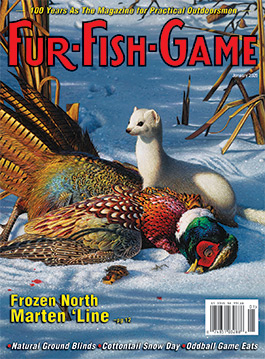
Features
The Letter - Jack Wentzel’s tribute to his best friend and hunting and fishing buddy, Andy Potocek, who changed Jack’s life.
Carte Blanche Cottontails - Phil Goes and Junie B, his English cocker spaniel, go cottontail hunting on a snow day from school.
Quebec Marten Trapping - B. P. Dinan shares a look at marten trapping tips, techniques and conservation north of the border.
Firmly Grounded - Joe Blake looks at tips and tactics for using natural and man-made ground blinds to bowhunt from the ground.
The Great Bear Hunt - Matthew Grice shares how North Carolina’s burgeoning bear population is the setting for this hunt over Plott hounds, the state dog.
The Difficult Ones - Herbert Lenon kicks off F-F-G’s 100th anniversary with this story from the January 1964 issue.
Other Articles
• Oddball Game Meals – Bruce Ingram shares his gastronomic adventures with possum, coon, beaver and merganser
• Wolves of the Birchwood, Chapter 5 – More Lew and Charlie adventures.
• My Hunting Partner Saved My Life – Ben Burklholder tells how an elk hunt in cold weather could have turned into a survival situation had it not been for his hunting partner.
• Winter Pigs – Chad Incorvia and a friend hunt javelina in Arizona and feral pigs in Hawaii.
• Smoking Trout – Doug Olson used to dislike eating trout, until he learned how to smoke them to make a delicious meal.
• Wisconsin Women’s Trapping Camp -David Zeug tells how Wisconsin’s program to get women into trapping is working.
• The Goose Gun – W.D. Baker shares his story of how a Marlin Goose Gun facilitated his journey from boyhood to manhood in a goose blind.
• Eyes In the Darkness – Cameron Kelsey shares a unique encounter with a red fox that almost walked into his fox sets one dark autumn morning.
• Lessons From the Book of the Woods – Ben Johnson, a bibliophile, sees the outdoors like a book, just waiting to be cracked open and read by anyone willing to take that plunge.
End of the Line Photo of the Month
Andy Miller (and Maggie), Coshocton, Ohio
SUBSCRIBE TO FUR-FISH-GAME Magazine

